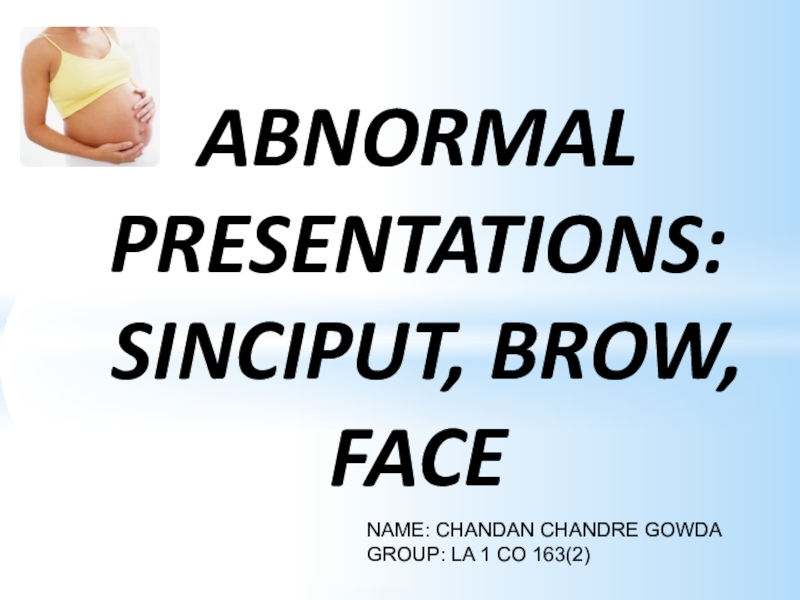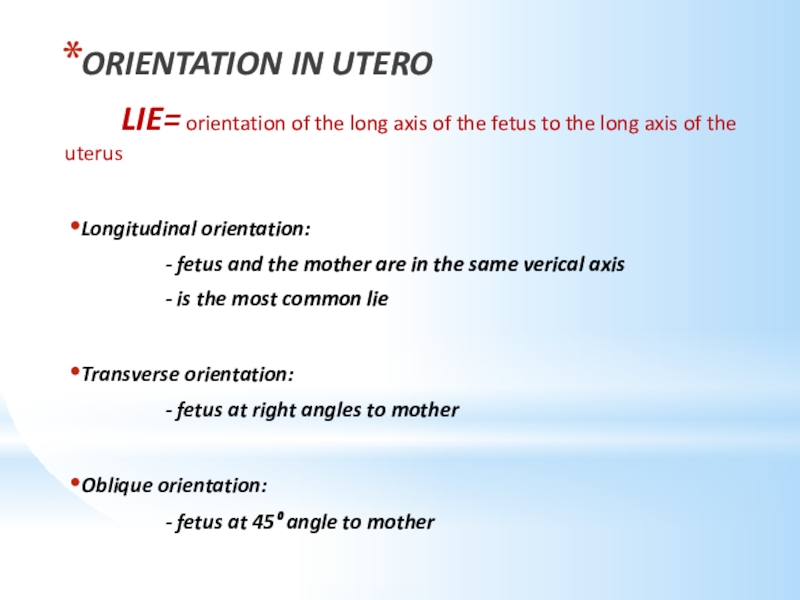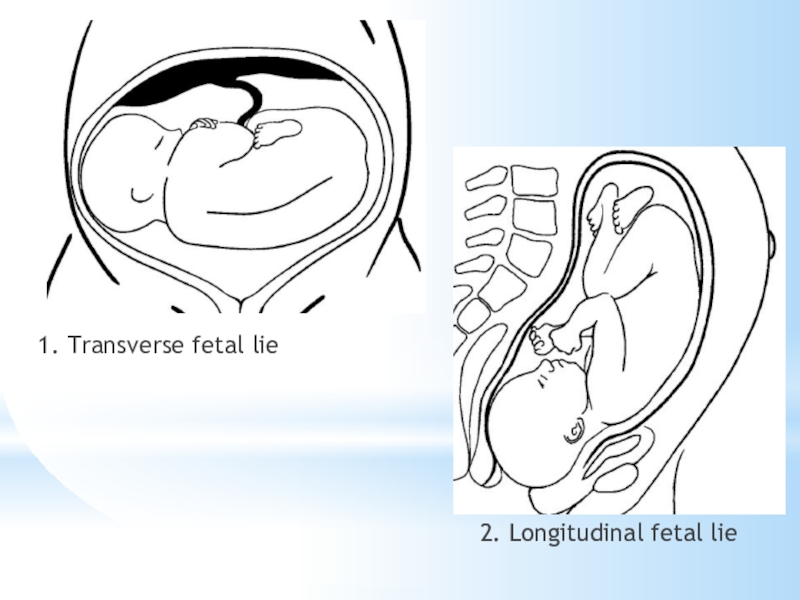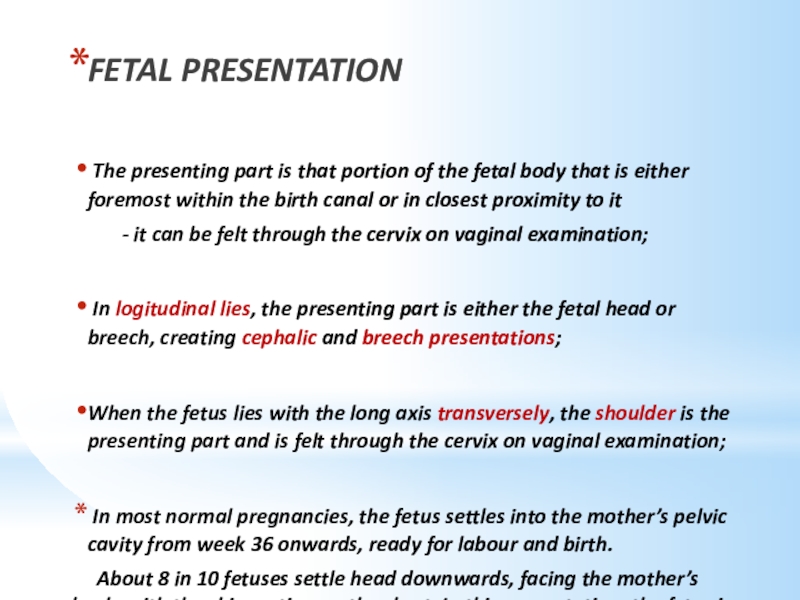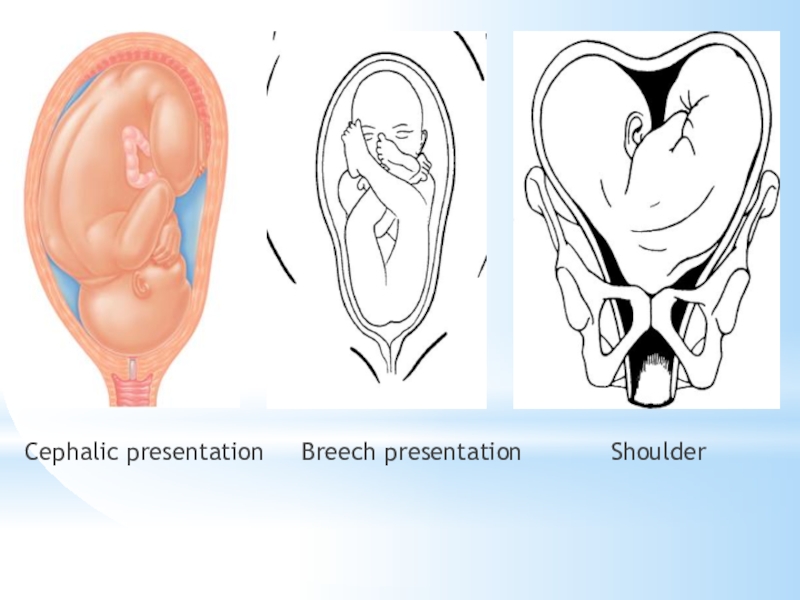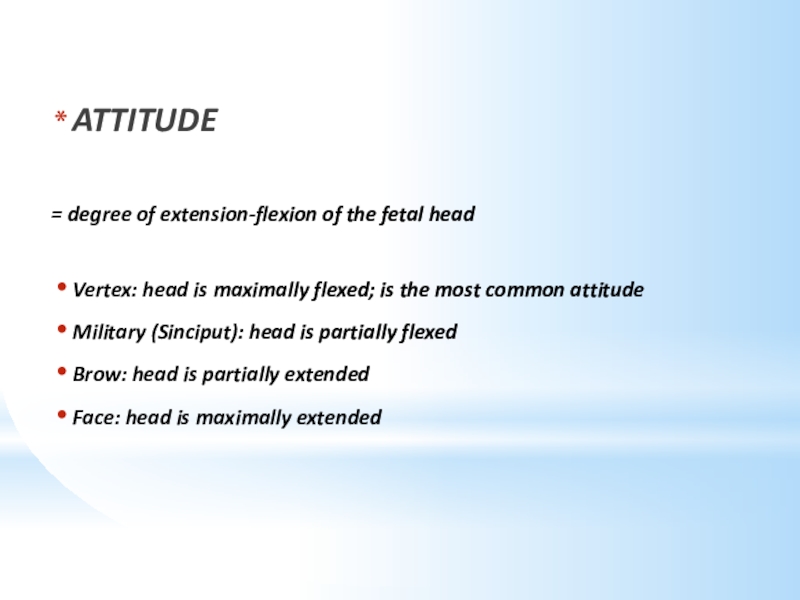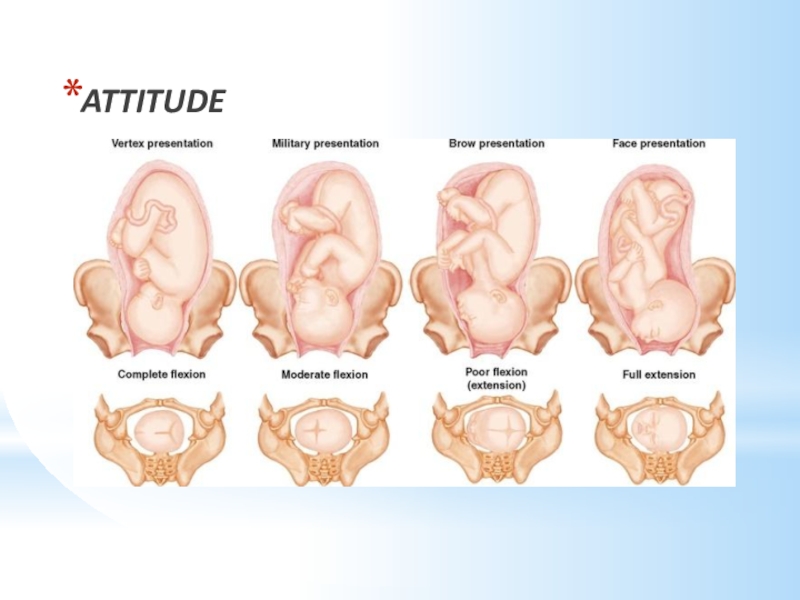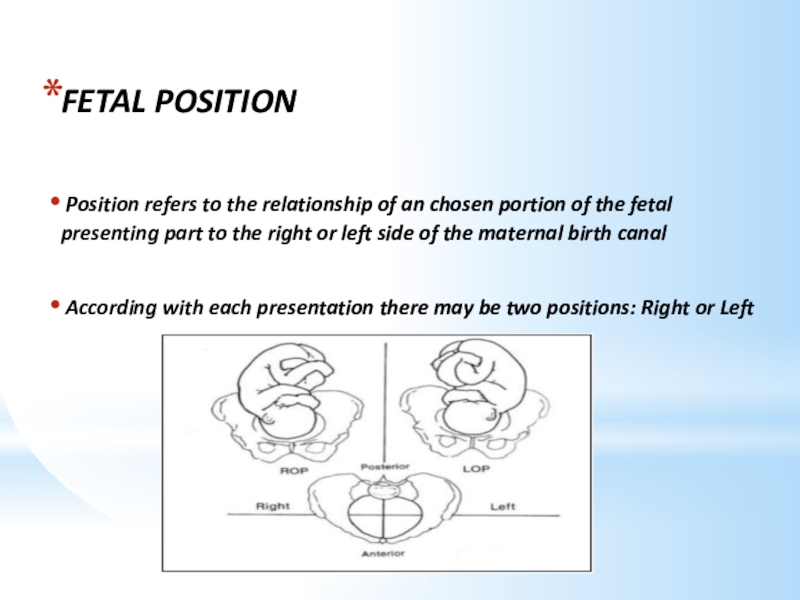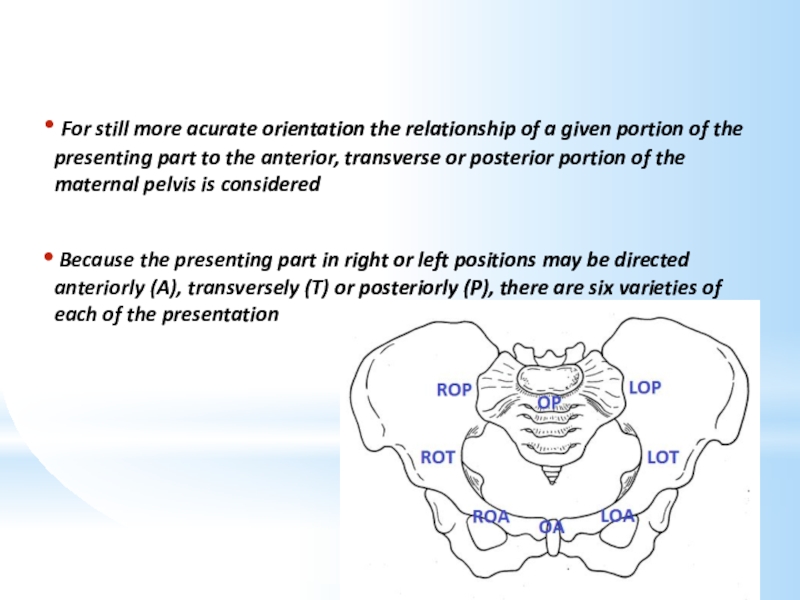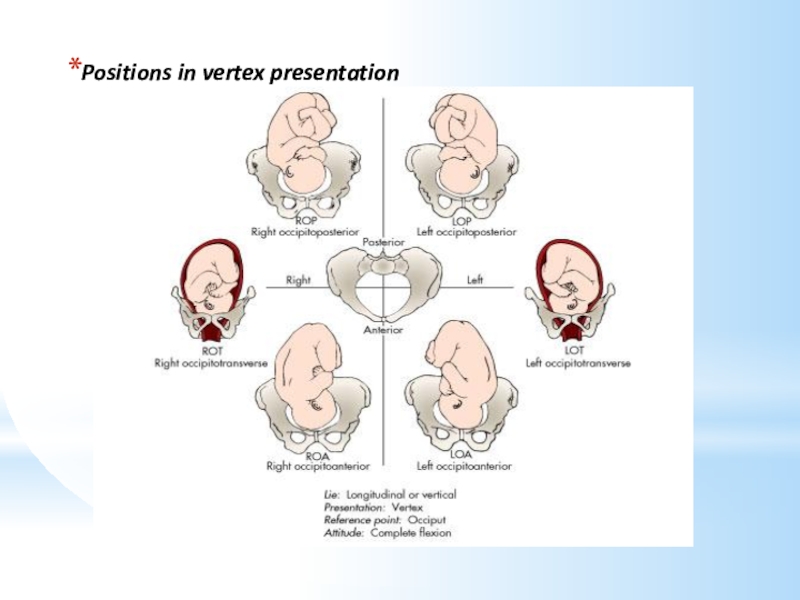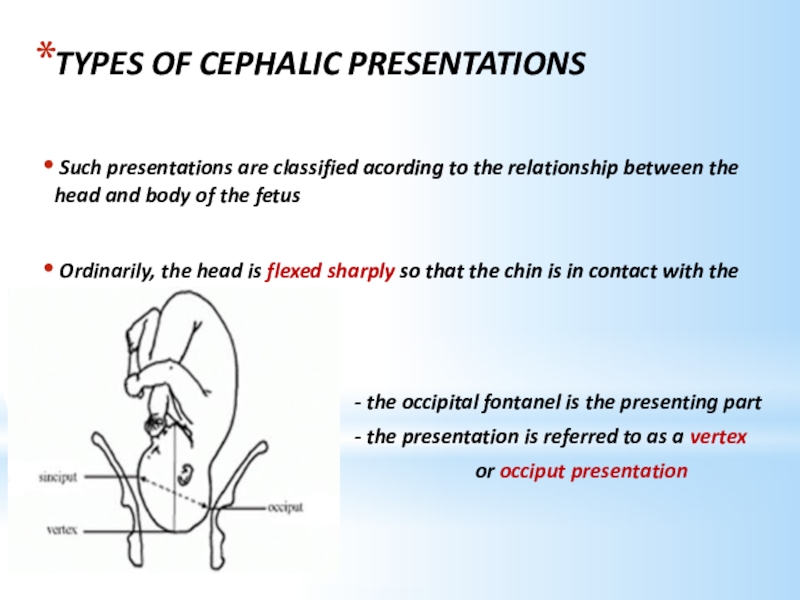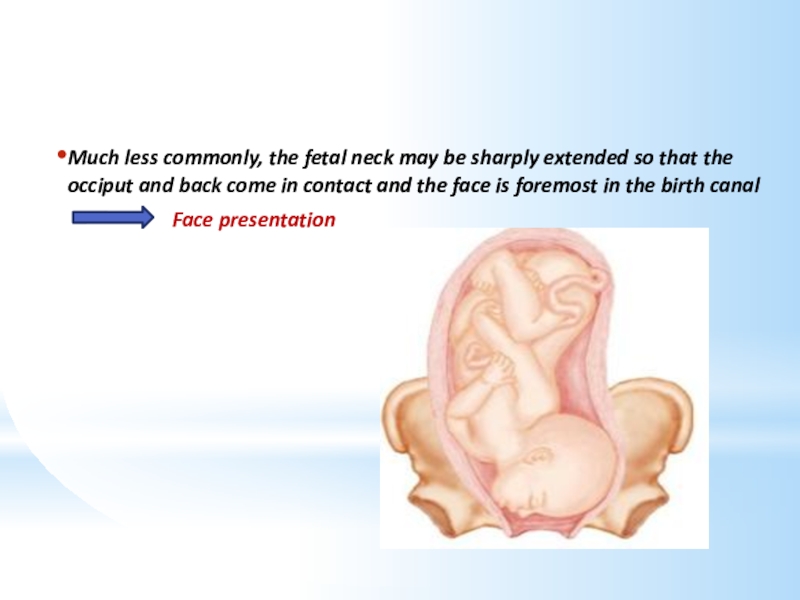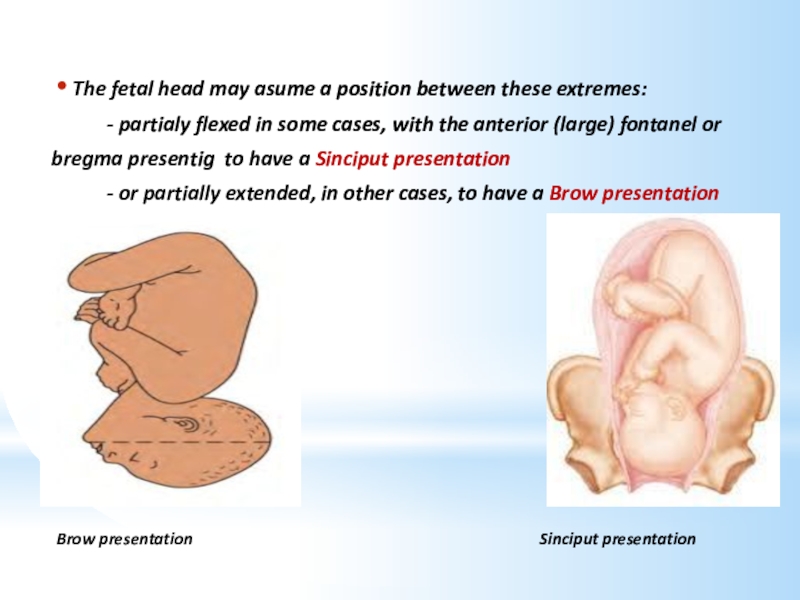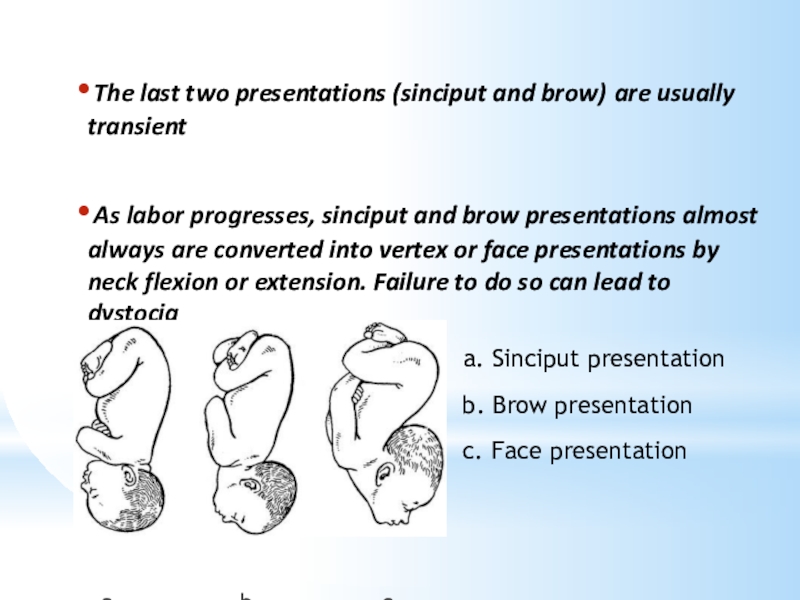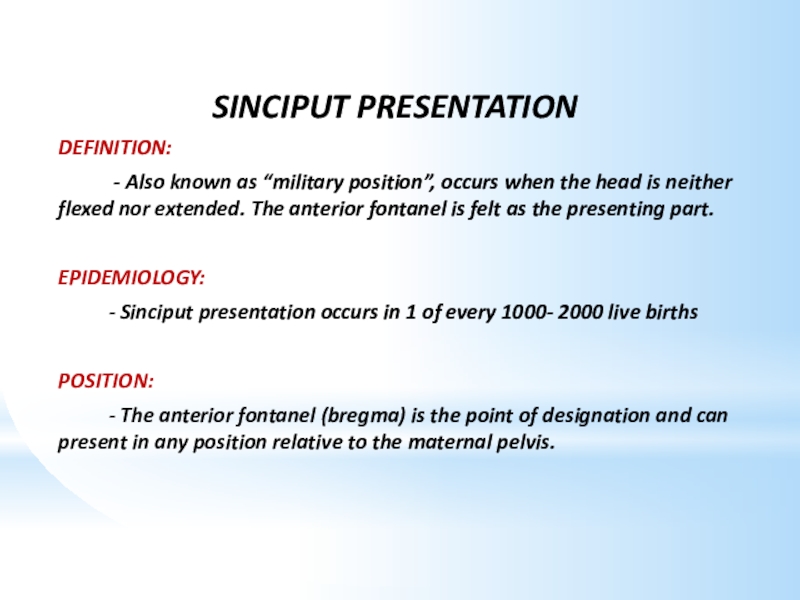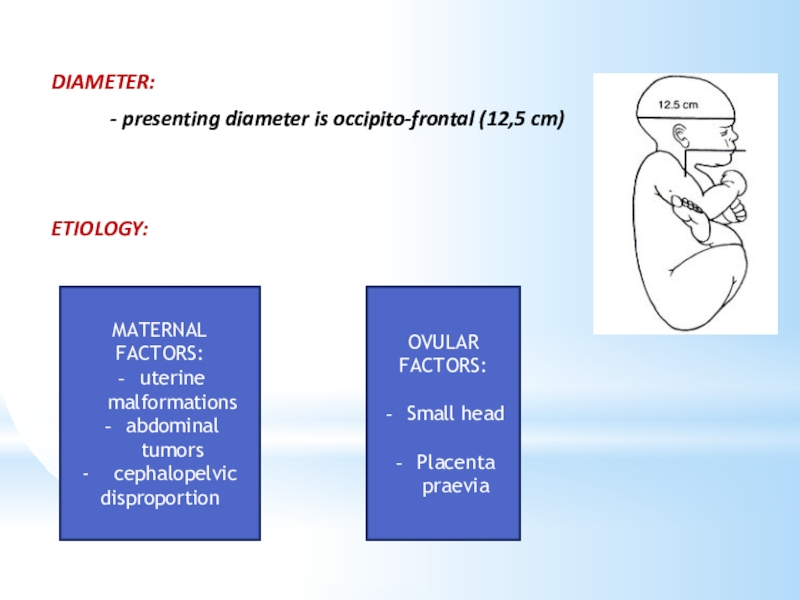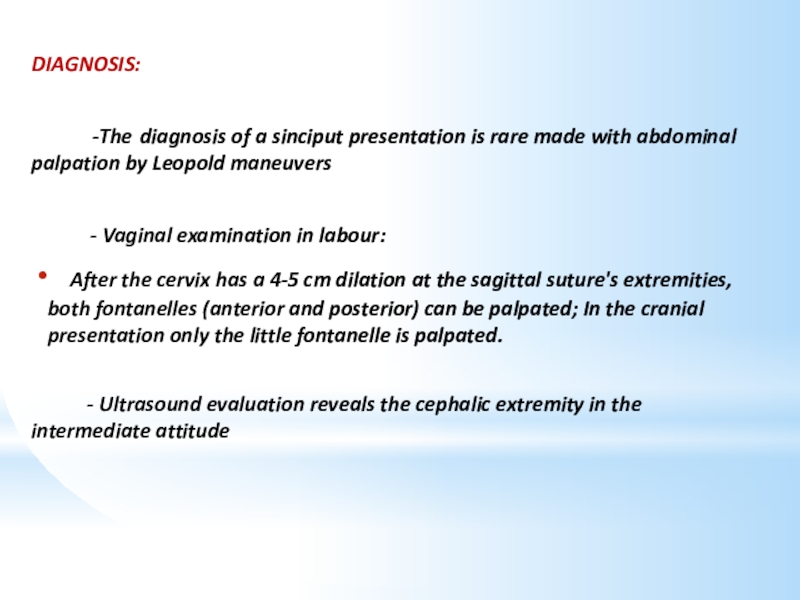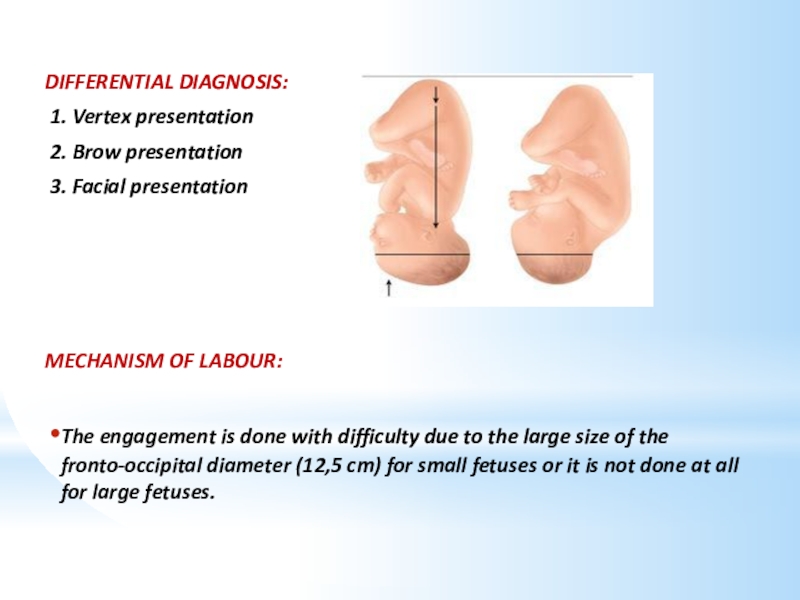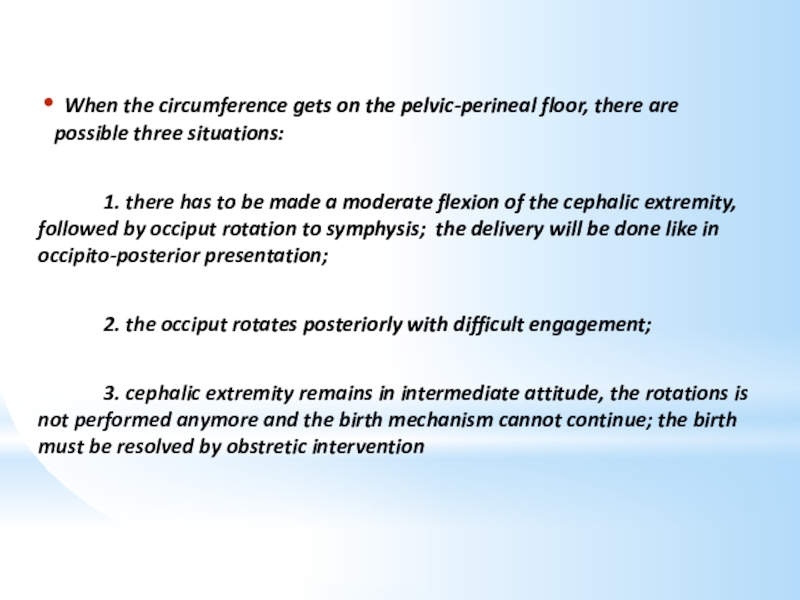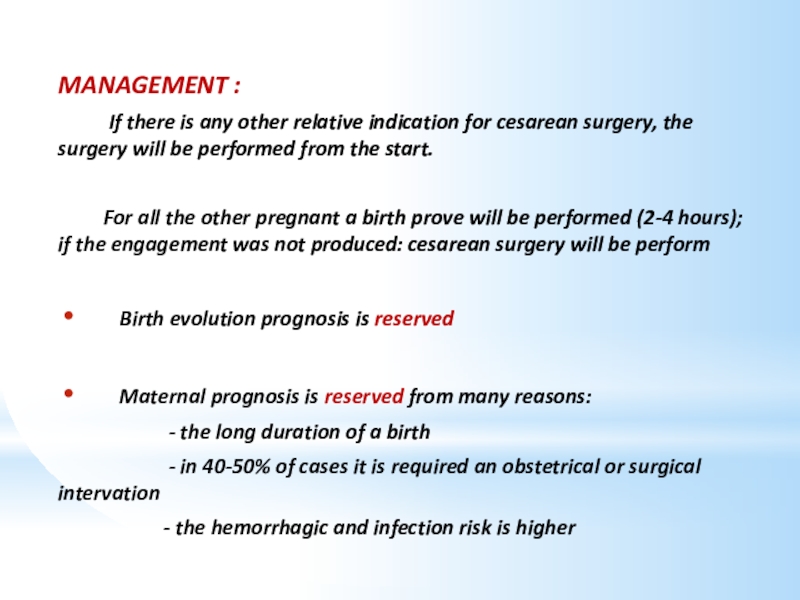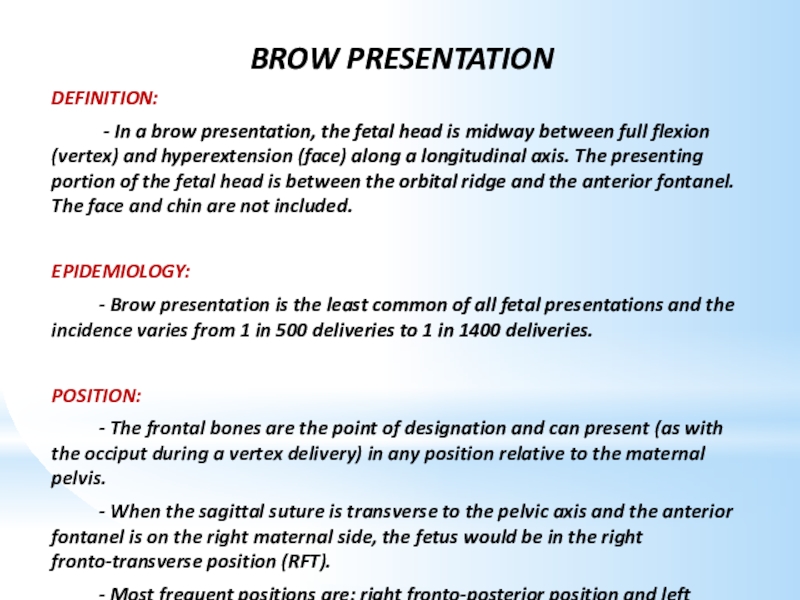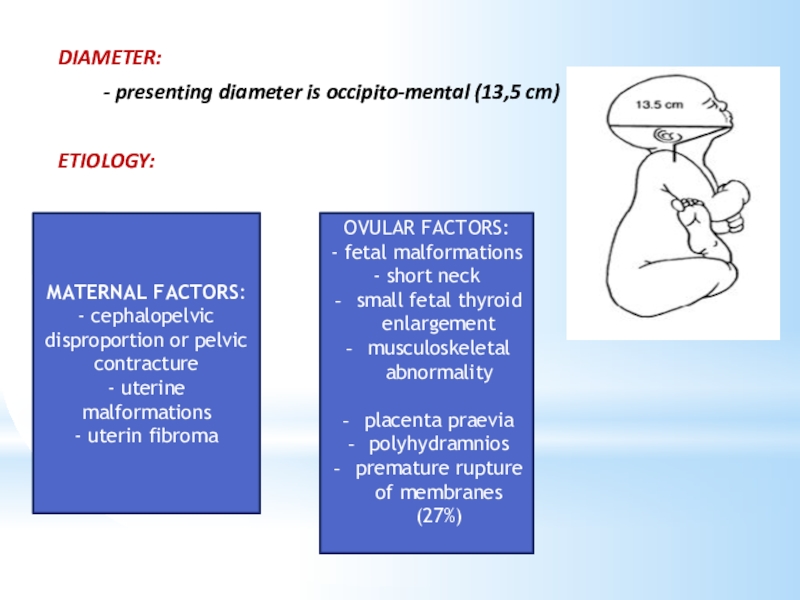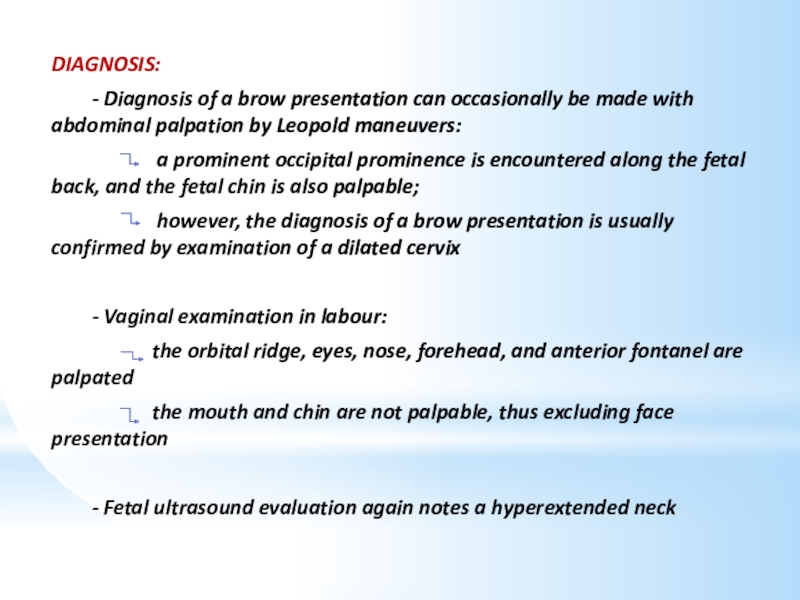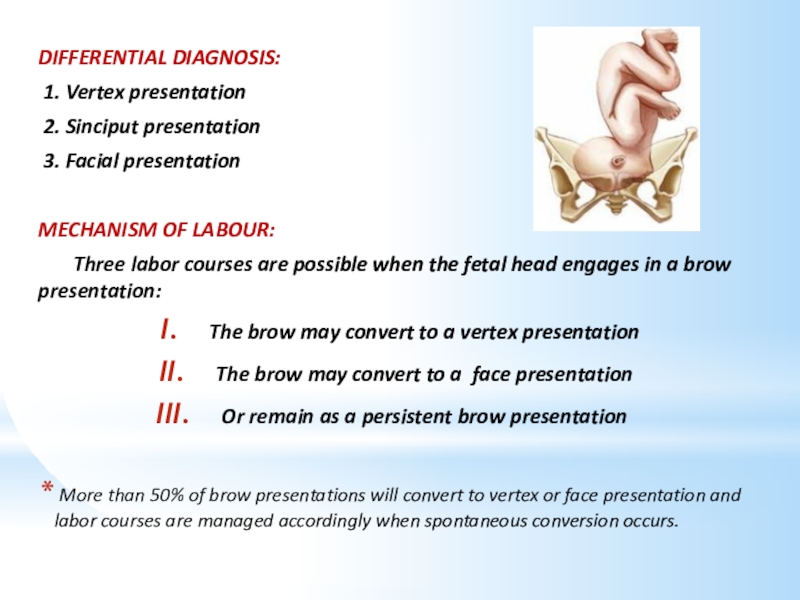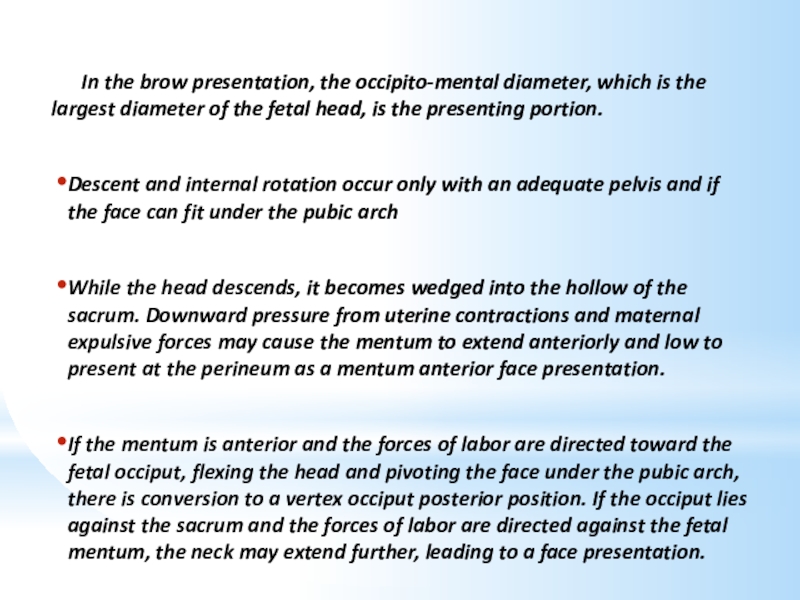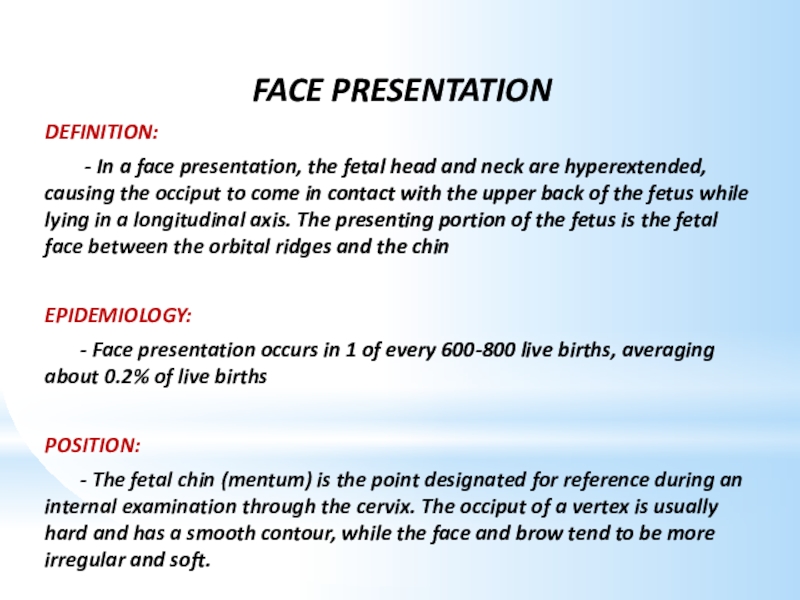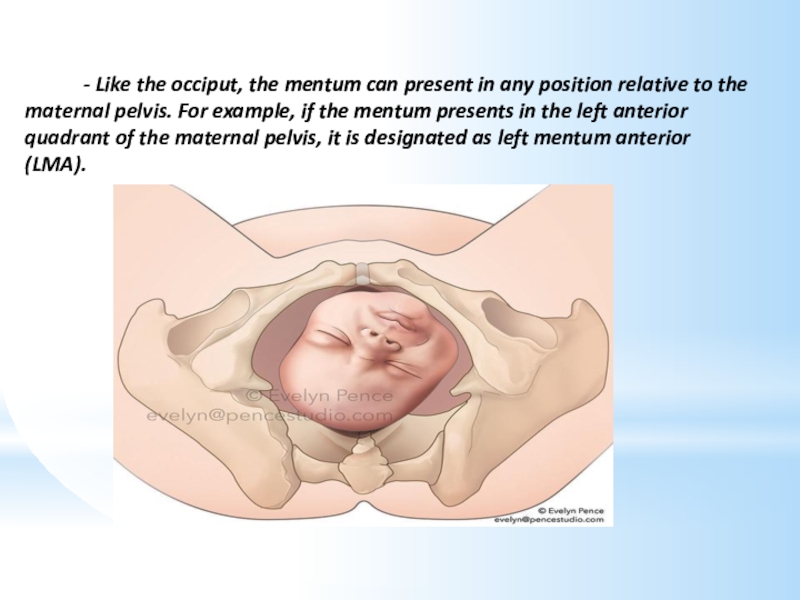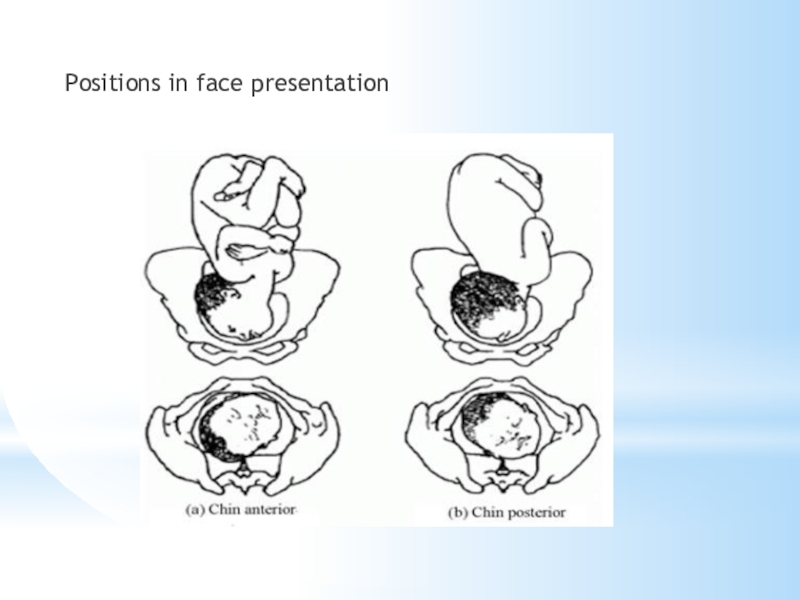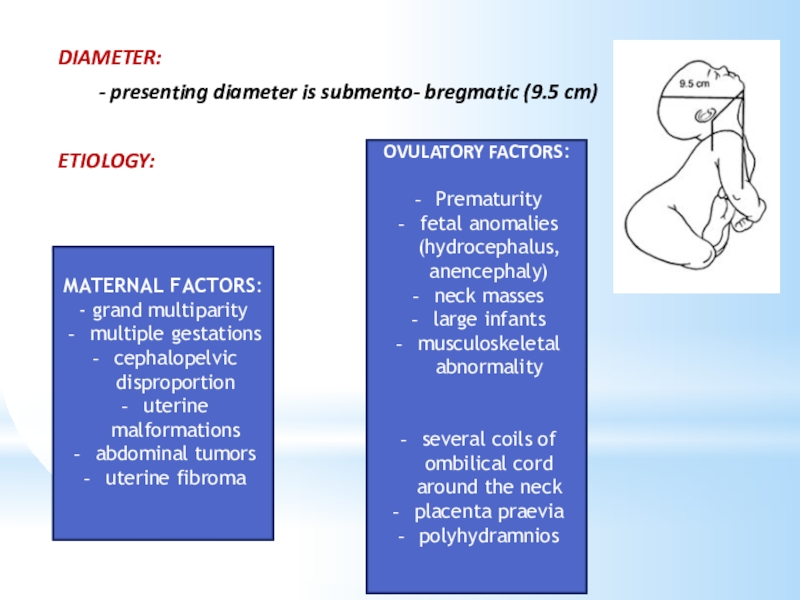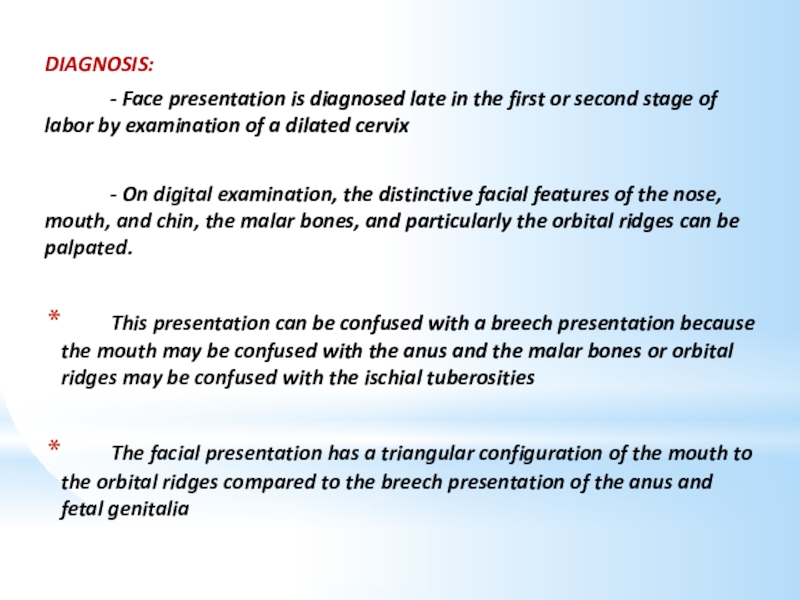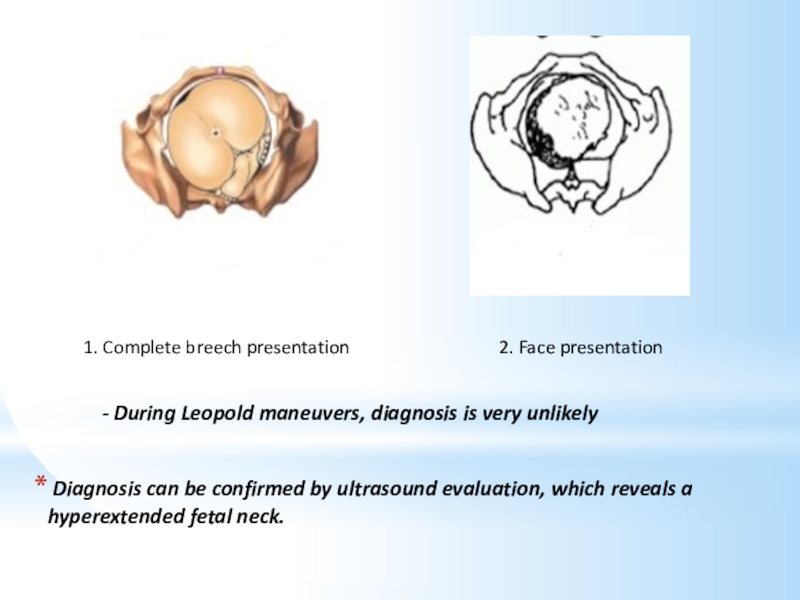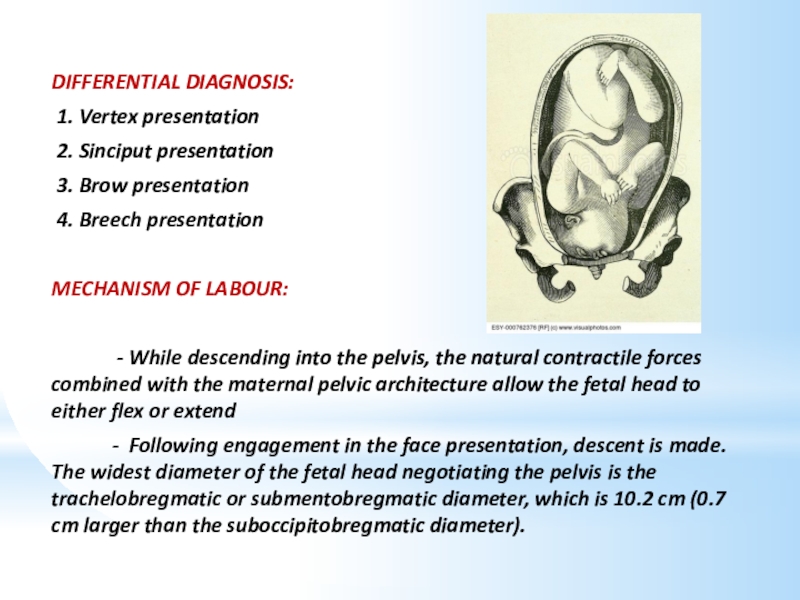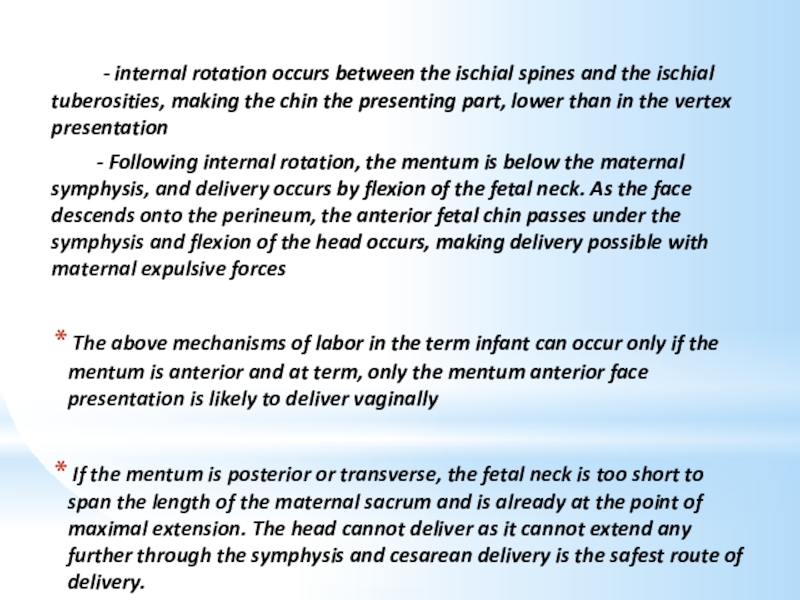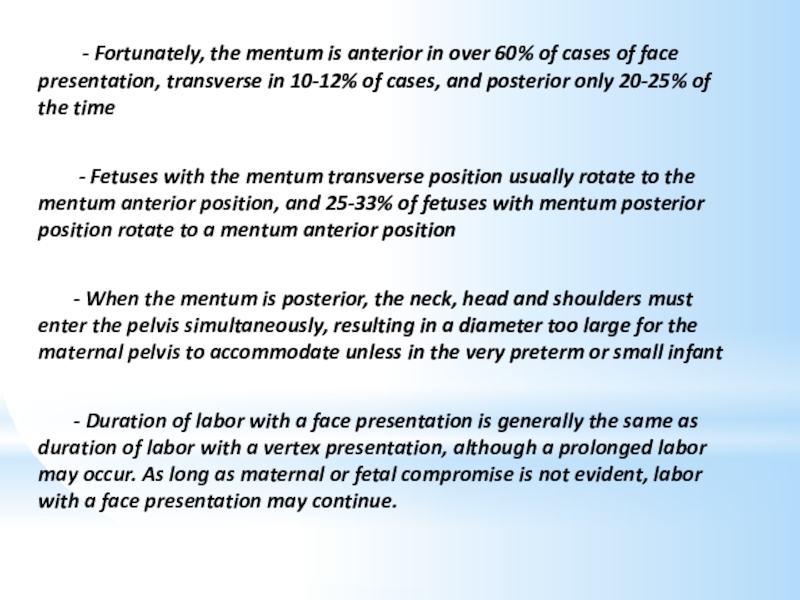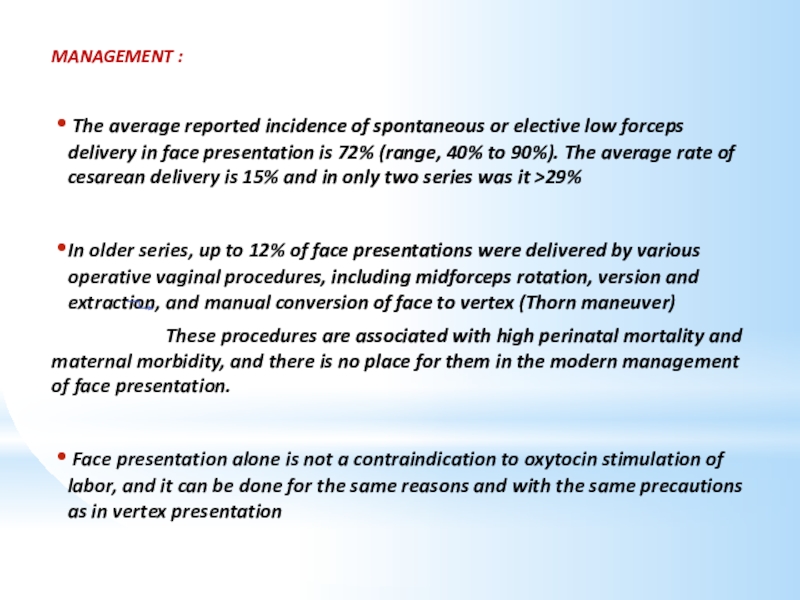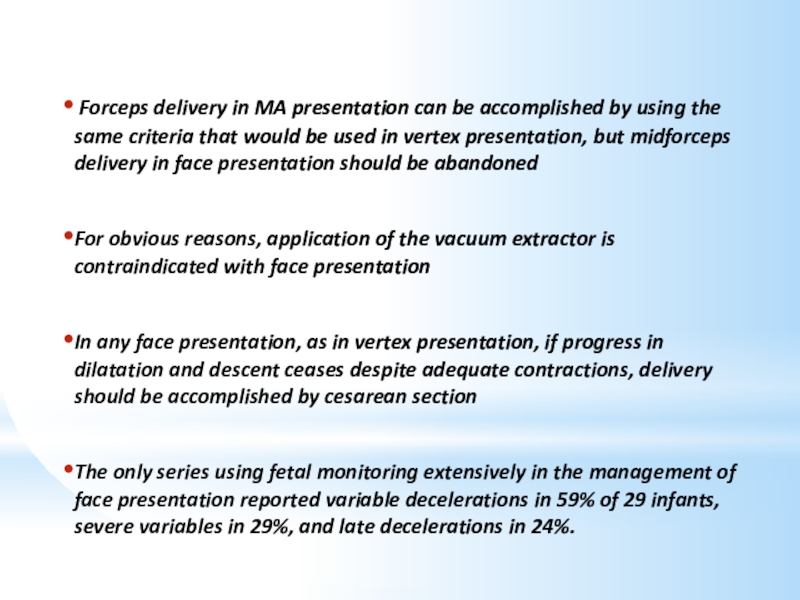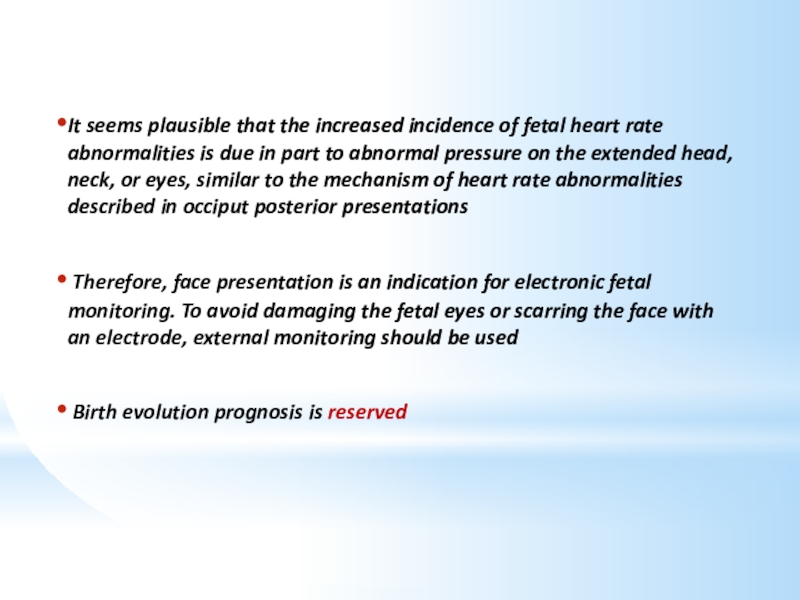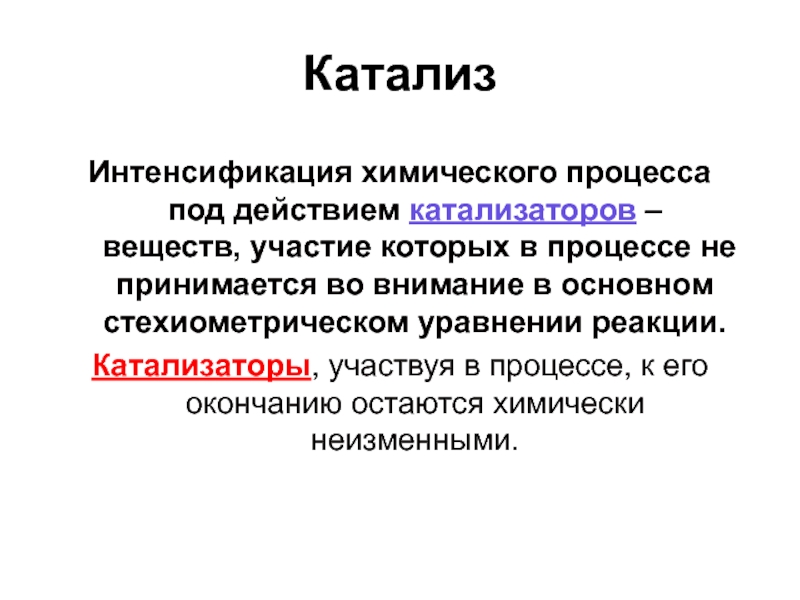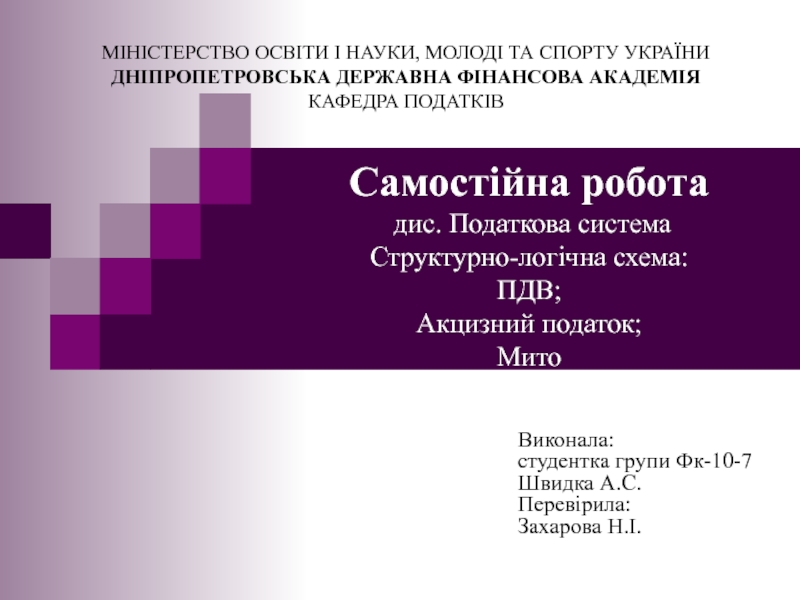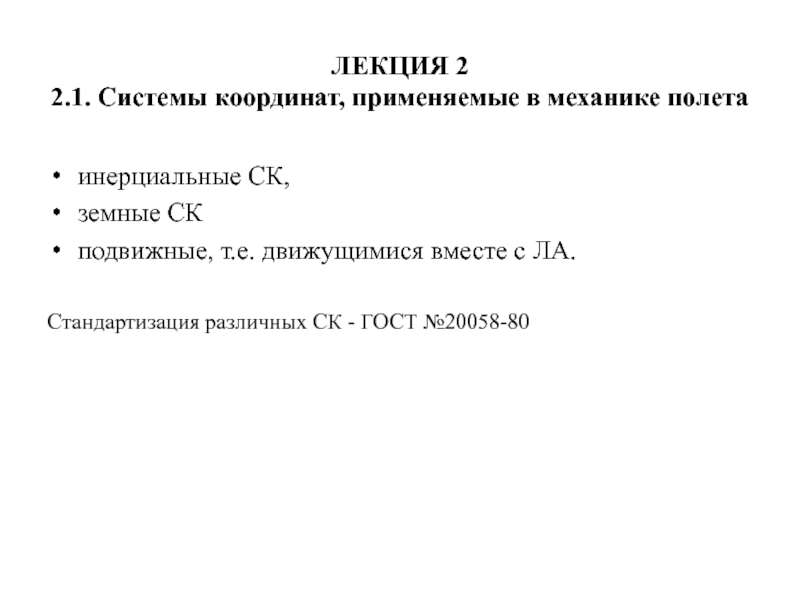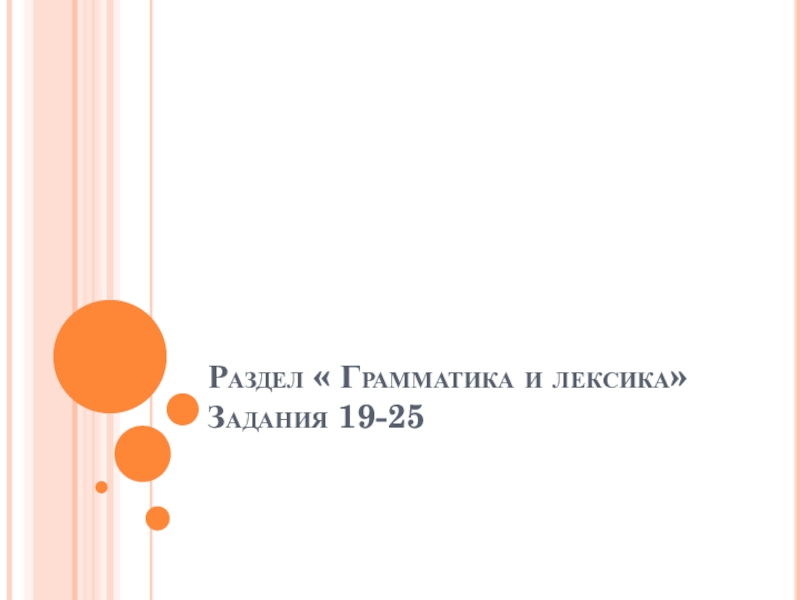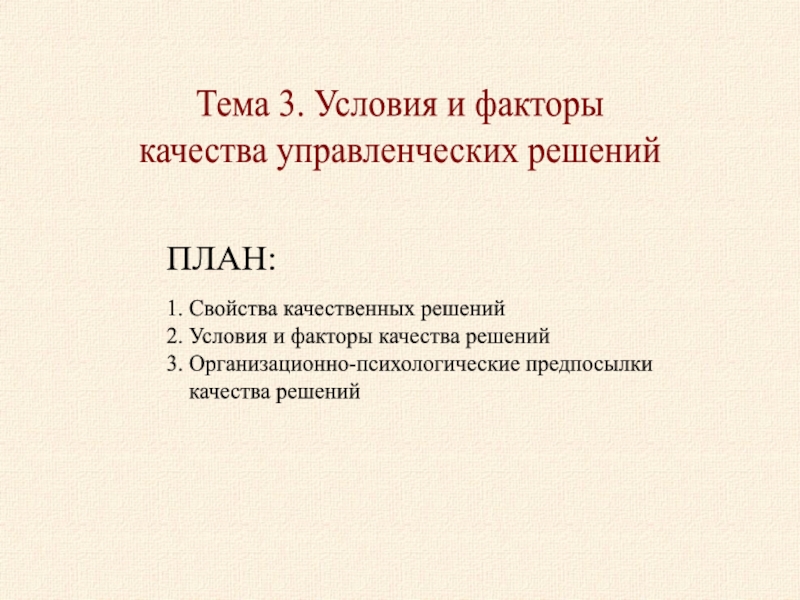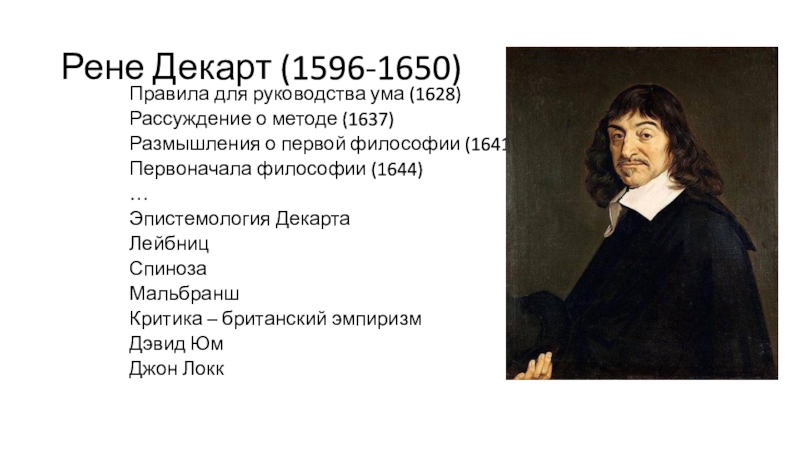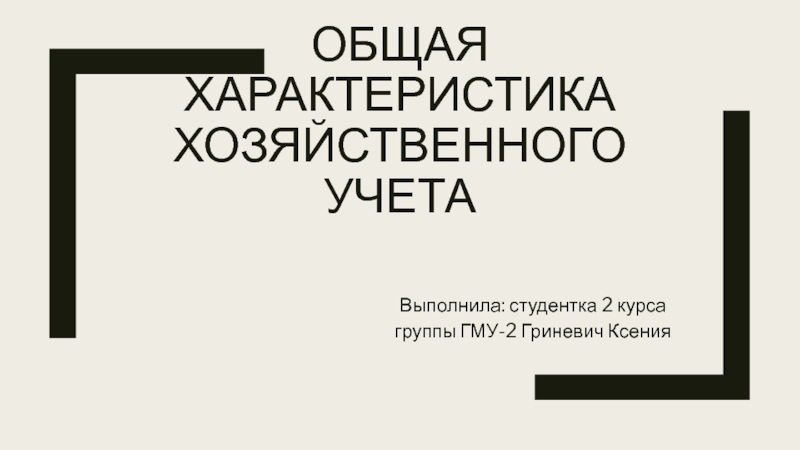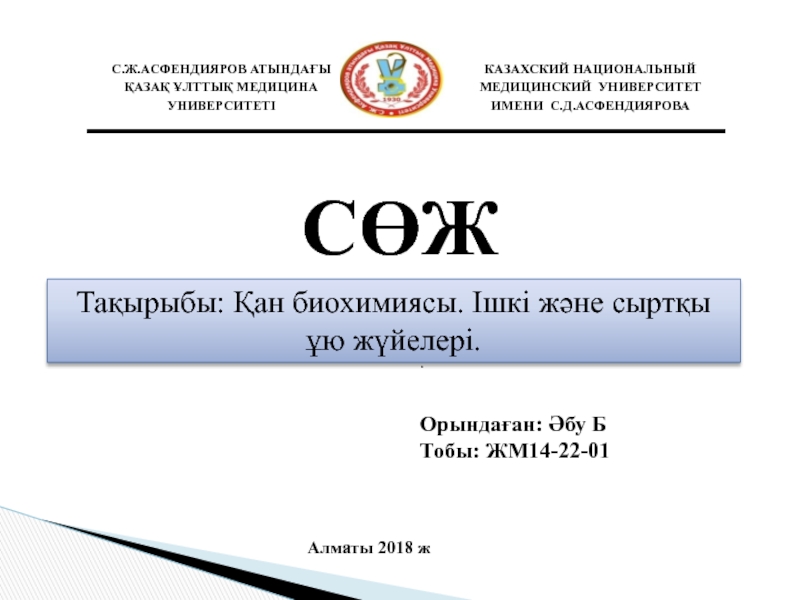Разделы презентаций
- Разное
- Английский язык
- Астрономия
- Алгебра
- Биология
- География
- Геометрия
- Детские презентации
- Информатика
- История
- Литература
- Математика
- Медицина
- Менеджмент
- Музыка
- МХК
- Немецкий язык
- ОБЖ
- Обществознание
- Окружающий мир
- Педагогика
- Русский язык
- Технология
- Физика
- Философия
- Химия
- Шаблоны, картинки для презентаций
- Экология
- Экономика
- Юриспруденция
ABNORMAL PRESENTATIONS: SINCIPUT, BROW, FACE NAME: CHANDAN CHANDRE GOWDA GROUP:
Содержание
- 1. ABNORMAL PRESENTATIONS: SINCIPUT, BROW, FACE NAME: CHANDAN CHANDRE GOWDA GROUP:
- 2. ORIENTATION IN UTERO LIE=
- 3. 1. Transverse fetal lie
- 4. FETAL PRESENTATION The presenting part is that
- 5. Cephalic presentation Breech presentation Shoulder
- 6. ATTITUDE= degree of extension-flexion of the
- 7. ATTITUDE
- 8. FETAL POSITION Position refers to the relationship
- 9. For still more acurate orientation the
- 10. Positions in vertex presentation
- 11. TYPES OF CEPHALIC PRESENTATIONS Such presentations are
- 12. Much less commonly, the fetal neck
- 13. The fetal head may asume a
- 14. The last two presentations (sinciput and
- 15. SINCIPUT PRESENTATIONDEFINITION:
- 16. DIAMETER: - presenting diameter
- 17. DIAGNOSIS: -The
- 18. DIFFERENTIAL DIAGNOSIS: 1. Vertex presentation 2. Brow
- 19. When
- 20. MANAGEMENT : If
- 21. BROW PRESENTATIONDEFINITION:
- 22. DIAMETER: - presenting
- 23. DIAGNOSIS: - Diagnosis of
- 24. DIFFERENTIAL DIAGNOSIS: 1. Vertex presentation 2. Sinciput
- 25. In the brow presentation,
- 26. Слайд 26
- 27. FACE PRESENTATIONDEFINITION: - In
- 28. - Like the
- 29. Positions in face presentation
- 30. DIAMETER: - presenting diameter
- 31. DIAGNOSIS:
- 32. 1. Complete breech
- 33. DIFFERENTIAL DIAGNOSIS: 1. Vertex presentation 2. Sinciput
- 34. - internal rotation
- 35. - Fortunately, the mentum
- 36. MANAGEMENT : The average reported incidence of
- 37. Forceps delivery in MA presentation can
- 38. It seems plausible that the increased incidence
- 39. THANK YOU
- 40. Скачать презентанцию
ORIENTATION IN UTERO LIE= orientation of the long axis of the fetus to the long axis of the uterusLongitudinal orientation:
Слайды и текст этой презентации
Слайд 1ABNORMAL PRESENTATIONS: SINCIPUT, BROW, FACE
NAME: CHANDAN CHANDRE GOWDA
GROUP: LA
1 CO 163(2)
Слайд 2ORIENTATION IN UTERO
LIE= orientation of the
long axis of the fetus to the long axis of
the uterusLongitudinal orientation:
- fetus and the mother are in the same verical axis
- is the most common lie
Transverse orientation:
- fetus at right angles to mother
Oblique orientation:
- fetus at 45⁰ angle to mother
Слайд 4FETAL PRESENTATION
The presenting part is that portion of the
fetal body that is either foremost within the birth canal
or in closest proximity to it- it can be felt through the cervix on vaginal examination;
In logitudinal lies, the presenting part is either the fetal head or breech, creating cephalic and breech presentations;
When the fetus lies with the long axis transversely, the shoulder is the presenting part and is felt through the cervix on vaginal examination;
In most normal pregnancies, the fetus settles into the mother’s pelvic cavity from week 36 onwards, ready for labour and birth.
About 8 in 10 fetuses settle head downwards, facing the mother’s back, with the chin resting on the chest. In this presentation, the fetus is in the optimum position for birth, and a normal vaginal delivery is usually possible
Слайд 6
ATTITUDE
= degree of extension-flexion of the fetal head
Vertex:
head is maximally flexed; is the most common attitude
Military
(Sinciput): head is partially flexedBrow: head is partially extended
Face: head is maximally extended
Слайд 8FETAL POSITION
Position refers to the relationship of an chosen
portion of the fetal presenting part to the right or
left side of the maternal birth canalAccording with each presentation there may be two positions: Right or Left
Слайд 9
For still more acurate orientation the relationship of
a given portion of the presenting part to the anterior,
transverse or posterior portion of the maternal pelvis is consideredBecause the presenting part in right or left positions may be directed anteriorly (A), transversely (T) or posteriorly (P), there are six varieties of each of the presentation
Слайд 11TYPES OF CEPHALIC PRESENTATIONS
Such presentations are classified acording to
the relationship between the head and body of the fetus
Ordinarily, the head is flexed sharply so that the chin is in contact with the torax- the occipital fontanel is the presenting part
- the presentation is referred to as a vertex
or occiput presentation
Слайд 12
Much less commonly, the fetal neck may be sharply
extended so that the occiput and back come in contact
and the face is foremost in the birth canalFace presentation
Слайд 13 The fetal head may asume a position between these
extremes:
- partialy flexed in
some cases, with the anterior (large) fontanel or bregma presentig to have a Sinciput presentation
- or partially extended, in other cases, to have a Brow presentation
Brow presentation Sinciput presentation
Слайд 14 The last two presentations (sinciput and brow) are usually
transient
As labor progresses, sinciput and brow presentations almost always
are converted into vertex or face presentations by neck flexion or extension. Failure to do so can lead to dystociaa. Sinciput presentation
b. Brow presentation
c. Face presentation
a. b. c.
Слайд 15
SINCIPUT PRESENTATION
DEFINITION:
- Also known
as “military position”, occurs when the head is neither flexed
nor extended. The anterior fontanel is felt as the presenting part.EPIDEMIOLOGY:
- Sinciput presentation occurs in 1 of every 1000- 2000 live births
POSITION:
- The anterior fontanel (bregma) is the point of designation and can present in any position relative to the maternal pelvis.
Слайд 16DIAMETER:
- presenting diameter is occipito-frontal (12,5
cm)
ETIOLOGY:
MATERNAL FACTORS:
uterine malformations
abdominal tumors
- cephalopelvic disproportion
OVULAR FACTORS:
Small head
Placenta
praeviaСлайд 17DIAGNOSIS:
-The diagnosis of a
sinciput presentation is rare made with abdominal palpation by Leopold
maneuvers- Vaginal examination in labour:
After the cervix has a 4-5 cm dilation at the sagittal suture's extremities, both fontanelles (anterior and posterior) can be palpated; In the cranial presentation only the little fontanelle is palpated.
- Ultrasound evaluation reveals the cephalic extremity in the intermediate attitude
Слайд 18DIFFERENTIAL DIAGNOSIS:
1. Vertex presentation
2. Brow presentation
3. Facial
presentation
MECHANISM OF LABOUR:
The engagement is done with difficulty due to
the large size of the fronto-occipital diameter (12,5 cm) for small fetuses or it is not done at all for large fetuses.Слайд 19
When the circumference gets
on the pelvic-perineal floor, there are possible three situations:
1. there has to be made a moderate flexion of the cephalic extremity, followed by occiput rotation to symphysis; the delivery will be done like in occipito-posterior presentation;2. the occiput rotates posteriorly with difficult engagement;
3. cephalic extremity remains in intermediate attitude, the rotations is not performed anymore and the birth mechanism cannot continue; the birth must be resolved by obstretic intervention
Слайд 20MANAGEMENT :
If there is any
other relative indication for cesarean surgery, the surgery will be
performed from the start.For all the other pregnant a birth prove will be performed (2-4 hours); if the engagement was not produced: cesarean surgery will be perform
Birth evolution prognosis is reserved
Maternal prognosis is reserved from many reasons:
- the long duration of a birth
- in 40-50% of cases it is required an obstetrical or surgical intervation
- the hemorrhagic and infection risk is higher
Слайд 21BROW PRESENTATION
DEFINITION:
- In a
brow presentation, the fetal head is midway between full flexion
(vertex) and hyperextension (face) along a longitudinal axis. The presenting portion of the fetal head is between the orbital ridge and the anterior fontanel. The face and chin are not included.EPIDEMIOLOGY:
- Brow presentation is the least common of all fetal presentations and the incidence varies from 1 in 500 deliveries to 1 in 1400 deliveries.
POSITION:
- The frontal bones are the point of designation and can present (as with the occiput during a vertex delivery) in any position relative to the maternal pelvis.
- When the sagittal suture is transverse to the pelvic axis and the anterior fontanel is on the right maternal side, the fetus would be in the right fronto-transverse position (RFT).
- Most frequent positions are: right fronto-posterior position and left fronto-anterior position
Слайд 22DIAMETER:
- presenting diameter is occipito-mental
(13,5 cm)
ETIOLOGY:
MATERNAL FACTORS:
- cephalopelvic disproportion or pelvic
contracture- uterine malformations
- uterin fibroma
OVULAR FACTORS:
- fetal malformations
- short neck
small fetal thyroid enlargement
musculoskeletal abnormality
placenta praevia
polyhydramnios
premature rupture of membranes (27%)
Слайд 23DIAGNOSIS:
- Diagnosis of a brow presentation
can occasionally be made with abdominal palpation by Leopold maneuvers:
a prominent occipital prominence is encountered along the fetal back, and the fetal chin is also palpable;
however, the diagnosis of a brow presentation is usually confirmed by examination of a dilated cervix
- Vaginal examination in labour:
the orbital ridge, eyes, nose, forehead, and anterior fontanel are palpated
the mouth and chin are not palpable, thus excluding face presentation
- Fetal ultrasound evaluation again notes a hyperextended neck
Слайд 24DIFFERENTIAL DIAGNOSIS:
1. Vertex presentation
2. Sinciput presentation
3. Facial
presentation
MECHANISM OF LABOUR:
Three labor courses are
possible when the fetal head engages in a brow presentation:The brow may convert to a vertex presentation
The brow may convert to a face presentation
Or remain as a persistent brow presentation
More than 50% of brow presentations will convert to vertex or face presentation and labor courses are managed accordingly when spontaneous conversion occurs.
Слайд 25 In the brow presentation, the occipito-mental diameter,
which is the largest diameter of the fetal head, is
the presenting portion.Descent and internal rotation occur only with an adequate pelvis and if the face can fit under the pubic arch
While the head descends, it becomes wedged into the hollow of the sacrum. Downward pressure from uterine contractions and maternal expulsive forces may cause the mentum to extend anteriorly and low to present at the perineum as a mentum anterior face presentation.
If the mentum is anterior and the forces of labor are directed toward the fetal occiput, flexing the head and pivoting the face under the pubic arch, there is conversion to a vertex occiput posterior position. If the occiput lies against the sacrum and the forces of labor are directed against the fetal mentum, the neck may extend further, leading to a face presentation.
Слайд 26
Most
experts would agree that there is no mechanism of successful
labor for a termsized persistent brow under most circumstances, and therefore vaginal delivery is impossible. However, vaginal delivery can occur if the fetus is quite small or if the pelvis is very largeMANAGEMENT :
If dilatation and descent are progressing normally, expectant management is best
Forceps deliveries are acceptable if the brow converts to MA face or vertex
Once progress in labor has ceased, persistent brow presentations require a cesarean delivery, and all operative vaginal maneuvers are contraindicated
Birth evolution prognosis is reserved
Слайд 27FACE PRESENTATION
DEFINITION:
- In a face presentation,
the fetal head and neck are hyperextended, causing the occiput
to come in contact with the upper back of the fetus while lying in a longitudinal axis. The presenting portion of the fetus is the fetal face between the orbital ridges and the chinEPIDEMIOLOGY:
- Face presentation occurs in 1 of every 600-800 live births, averaging about 0.2% of live births
POSITION:
- The fetal chin (mentum) is the point designated for reference during an internal examination through the cervix. The occiput of a vertex is usually hard and has a smooth contour, while the face and brow tend to be more irregular and soft.
Слайд 28 - Like the occiput, the mentum
can present in any position relative to the maternal pelvis.
For example, if the mentum presents in the left anterior quadrant of the maternal pelvis, it is designated as left mentum anterior (LMA).Слайд 30DIAMETER:
- presenting diameter is submento- bregmatic
(9.5 cm)
ETIOLOGY:
MATERNAL FACTORS:
- grand multiparity
multiple gestations
cephalopelvic disproportion
uterine malformations
abdominal tumors
uterine fibroma
OVULATORY
FACTORS:Prematurity
fetal anomalies (hydrocephalus, anencephaly)
neck masses
large infants
musculoskeletal abnormality
several coils of ombilical cord around the neck
placenta praevia
polyhydramnios
Слайд 31DIAGNOSIS:
- Face presentation
is diagnosed late in the first or second stage of
labor by examination of a dilated cervix- On digital examination, the distinctive facial features of the nose, mouth, and chin, the malar bones, and particularly the orbital ridges can be palpated.
This presentation can be confused with a breech presentation because the mouth may be confused with the anus and the malar bones or orbital ridges may be confused with the ischial tuberosities
The facial presentation has a triangular configuration of the mouth to the orbital ridges compared to the breech presentation of the anus and fetal genitalia
Слайд 32
1. Complete breech presentation
2. Face presentation
- During Leopold maneuvers, diagnosis is very unlikely
Diagnosis can be confirmed by ultrasound evaluation, which reveals a hyperextended fetal neck.
Слайд 33DIFFERENTIAL DIAGNOSIS:
1. Vertex presentation
2. Sinciput presentation
3. Brow
presentation
4. Breech presentation
MECHANISM OF LABOUR:
- While descending into the pelvis, the natural contractile forces combined with the maternal pelvic architecture allow the fetal head to either flex or extend- Following engagement in the face presentation, descent is made. The widest diameter of the fetal head negotiating the pelvis is the trachelobregmatic or submentobregmatic diameter, which is 10.2 cm (0.7 cm larger than the suboccipitobregmatic diameter).
Слайд 34 - internal rotation occurs between the
ischial spines and the ischial tuberosities, making the chin the
presenting part, lower than in the vertex presentation- Following internal rotation, the mentum is below the maternal symphysis, and delivery occurs by flexion of the fetal neck. As the face descends onto the perineum, the anterior fetal chin passes under the symphysis and flexion of the head occurs, making delivery possible with maternal expulsive forces
The above mechanisms of labor in the term infant can occur only if the mentum is anterior and at term, only the mentum anterior face presentation is likely to deliver vaginally
If the mentum is posterior or transverse, the fetal neck is too short to span the length of the maternal sacrum and is already at the point of maximal extension. The head cannot deliver as it cannot extend any further through the symphysis and cesarean delivery is the safest route of delivery.
Слайд 35 - Fortunately, the mentum is anterior in
over 60% of cases of face presentation, transverse in 10-12%
of cases, and posterior only 20-25% of the time- Fetuses with the mentum transverse position usually rotate to the mentum anterior position, and 25-33% of fetuses with mentum posterior position rotate to a mentum anterior position
- When the mentum is posterior, the neck, head and shoulders must enter the pelvis simultaneously, resulting in a diameter too large for the maternal pelvis to accommodate unless in the very preterm or small infant
- Duration of labor with a face presentation is generally the same as duration of labor with a vertex presentation, although a prolonged labor may occur. As long as maternal or fetal compromise is not evident, labor with a face presentation may continue.
Слайд 36MANAGEMENT :
The average reported incidence of spontaneous or elective
low forceps delivery in face presentation is 72% (range, 40%
to 90%). The average rate of cesarean delivery is 15% and in only two series was it >29%In older series, up to 12% of face presentations were delivered by various operative vaginal procedures, including midforceps rotation, version and extraction, and manual conversion of face to vertex (Thorn maneuver)
These procedures are associated with high perinatal mortality and maternal morbidity, and there is no place for them in the modern management of face presentation.
Face presentation alone is not a contraindication to oxytocin stimulation of labor, and it can be done for the same reasons and with the same precautions as in vertex presentation
Слайд 37
Forceps delivery in MA presentation can be accomplished by
using the same criteria that would be used in vertex
presentation, but midforceps delivery in face presentation should be abandonedFor obvious reasons, application of the vacuum extractor is contraindicated with face presentation
In any face presentation, as in vertex presentation, if progress in dilatation and descent ceases despite adequate contractions, delivery should be accomplished by cesarean section
The only series using fetal monitoring extensively in the management of face presentation reported variable decelerations in 59% of 29 infants, severe variables in 29%, and late decelerations in 24%.
Слайд 38
It seems plausible that the increased incidence of fetal heart
rate abnormalities is due in part to abnormal pressure on
the extended head, neck, or eyes, similar to the mechanism of heart rate abnormalities described in occiput posterior presentationsTherefore, face presentation is an indication for electronic fetal monitoring. To avoid damaging the fetal eyes or scarring the face with an electrode, external monitoring should be used
Birth evolution prognosis is reserved
